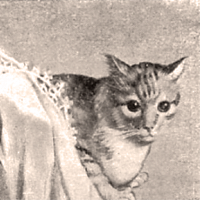Last year Gioja Ralui, author of the books Sardinian Knot Stitch (in English) and Punto Annodato Sardo (in Italian) appeared here and elsewhere as a guest to present a freebie snowflake pattern, this year she goes a step further to present a project of snowflakes! If you would like to read this post in Italian, please go to either blog: ricamo e... altro or TuttoRicamo. I turn the blog over to her, so she can tell you all about it:
Christmas Table Mat
As you can see it is a cascade of snowflakes of various sizes, each one different from the other. They are all enclosed in a frame of a simple zig zag with the 'gruxittasa' (remember that the 'x' must be read as the French 'j') pattern in each corner and in the middle of each side. [gruxittasa means 'the crosses' in Sardinian] Finally, to complete the project, some drawn-thread work (removing two fabric threads): the simple hem stitch for securing the hem and along the edge, the arches with picots that make up the classic edging of Sardinian Knot Stitch works.
Information on how to realize the hem with the mitred corners and the simple hemstitch can be found in large quantities in the internet. I limit myself to a couple of suggestions:
mitred corners
simple hemstitch
However if these do not seem comprehensive enough, type in a search engine 'tutorial mitred corners' and 'tutorial simple hemstitch' and you will find everything you need.
Some of the snowflakes on this embroidered table mat were published in my book Sardinian Knot Stitch and are not repeated here. I would like to remind readers that in it you will find all the instructions for the work, both with regard to the stitch execution and the needle lace edging. Remember too, that the proceeds from sales go to charity. Last year over $2,500.00 US dollars were donated to the Catholic Mission of Camp Garba in Kenya allowing kids to to attend school in the area. I wonder if this year you will help me achieve the same result?
As I mentioned above, for the execution of the table mat, 28ct Assisi linen fabric in beige with Anchor Ritorto Fiorentino no. 12 pearl cotton, colour no. 47 was used. The dimensions of the fabric are: 41 cm x 33.5 cm which includes the 1.5 cm to be folded back on each side to form the hem.
In the photo below, numbers have been assigned to facilitate the recognition of the snowflakes in relation to the corresponding patterns:
Below are the patterns of the other previously unpublished snowflakes:
Snowflakes numbered 7 and 8.
And finally, snowflake number 9 and the patterns for the frame of zig zag with gruxittasa which is executed 1 cm to the inside of the drawn-thread work hemstitching.
One last tip: although I realize that each of us has his own method of working: I do the hemstitching first (but the arches I leave until last) because it helps me with the placement of the rest of the embroidery... but it is not written in stone that you must do it this way!
Happy Stitching!






















































